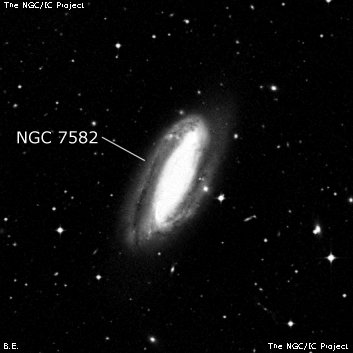
James Dunlop discovered NGC 7582 = D 476 = h3977 on 7 Jul 1826 and recorded "a small faint round nebula, about 30" diameter: a double nebula follow this." John Herschel made a single observation on 2 Sep 1836 and described "pB, L, pmE, gbM." His declination is 15' too large. DeLisle Stewart's corrected declination in the IC 2 notes (from Ann Harv Coll Obs, vol LX, p175) is accurate.
When Pietro Baracchi observed the field on 2 Nov 1885 with the Great Melbourne Telescope, he couldn't find NGC 7582 at Herschel's position, but instead picked up MCG -07-47-031, an uncredited discovery.
300/350mm - 13.1" (11/5/83): fairly large, diffuse, elongated NNW-SSE. First of three in the field with NGC 7590 9.8' NE and NGC 7599 12.6' NE.
600/800mm - 30" (10/21/17 - OzSky): at 264x; extremely bright, very large, very elongated ~3:1 NNW-SSE, ~3.6'x1.2'. Strong concentration with an extremely bright elongated core and a prominent quasi-stellar nucleus. This barred spiral is brighter along the spine of the major axis and displays a mottled or patchy surface brightness. NGC 7582 is the largest and most impressive in the Grus Triplet with NGC 7590 5' NE and NGC 7599 12.5' NE.
Notes by Steve Gottlieb